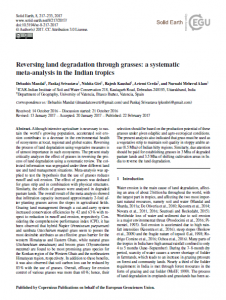Although intensive agriculture is necessary to sustain the world’s growing population, accelerated soil erosion contributes to a decrease in the environmental health of ecosystems at local, regional and global scales. Reversing the process of land degradation using vegetative measures is of utmost importance in such ecosystems. The present study critically analyses the effect of grasses in reversing the process of land degradation using a systematic review. The collected information was segregated under three different land use and land management situations. Meta-analysis was applied to test the hypothesis that the use of grasses reduces runoff and soil erosion. The effect of grasses was deduced for grass strip and in combination with physical structures. Similarly, the effects of grasses were analysed in degraded pasture lands. The overall result of the meta-analysis showed that infiltration capacity increased approximately 2-fold after planting grasses across the slopes in agricultural fields. Grazing land management through a cut-and-carry system increased conservation efficiencies by 42 and 63% with respect to reduction in runoff and erosion, respectively. Considering the comprehensive performance index (CPI), it has been observed that hybrid Napier (Pennisetum purpureum) and sambuta (Saccharum munja) grass seem to possess the most desirable attributes as an effective grass barrier for the western Himalayas and Eastern Ghats, while natural grass (Dichanthium annulatum) and broom grass (Thysanolaena maxima) are found to be the most promising grass species for the Konkan region of the Western Ghats and the northeastern Himalayan region, respectively. In addition to these benefits, it was also observed that soil carbon loss can be reduced by 83% with the use of grasses. Overall, efficacy for erosion control of various grasses was more than 60%; hence, their selection should be based on the production potential of these grasses under given edaphic and agro-ecological conditions. The present analysis also indicated that grass must be used as a vegetative strip to maintain soil quality in sloppy arable areas (8.5Mha) of Indian hilly regions. Similarly, due attention should be paid to establishing grasses in 3Mha of degraded pasture lands and 3.5Mha of shifting cultivation areas in India to reverse the land degradation.
Region: India
Date published:
2017
Published by:
Solid Earth
Type of resource:
Journal article
Resource topic:
Grass, Land degradation
Project/Programme: Not specific
Pest/Disease: Not specific
Pages:
17
File type:
External link (4 MB)




